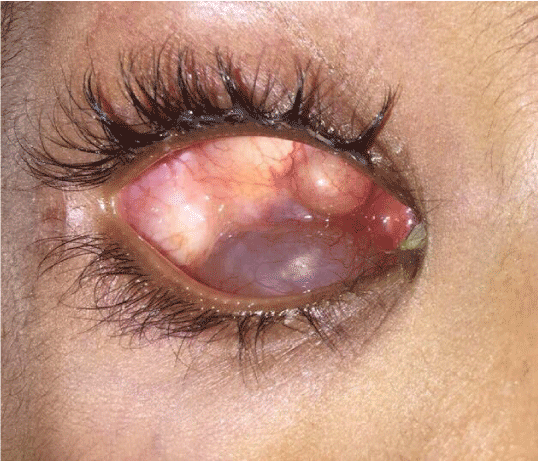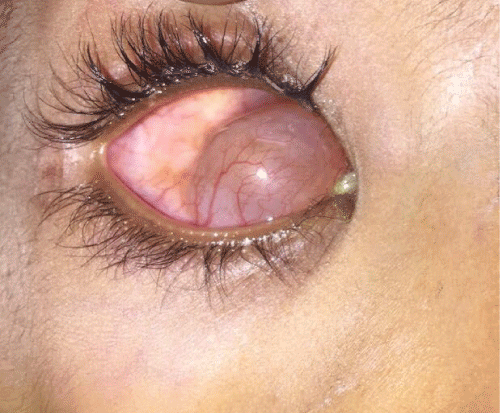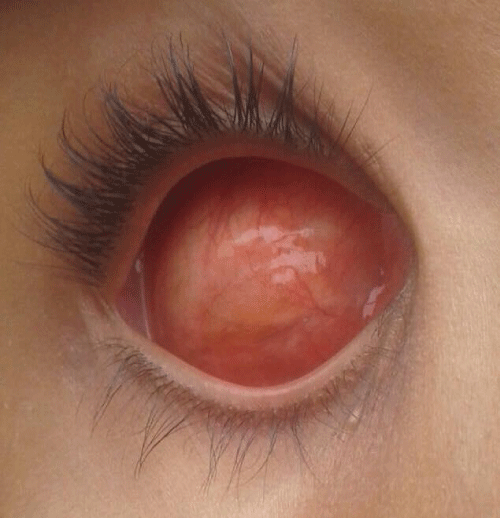Journal of Clinical Research and Ophthalmology
Rare case of a conjunctival cyst formation in an anophthalmic socket of a 10 years old patient
Mohamed Abdallahi Ould Hamed*, Imane Tarib and Fouad Elasri
Cite this as
Ould Hamed MA, Tarib I, Elasri F (2018) Rare case of a conjunctival cyst formation in an anophthalmic socket of a 10 years old patient. J Clin Res Ophthalmol 5(1): 023-024. DOI: 10.17352/2455-1414.000050Evisceration is a widely performed surgery in the pediatric population, the most common etiology for children is trauma and malignant retinal tumors. The procedure is safe and the complications are rare and often easily manageable.
We report the case of a 10 years old male patient, who had undergone evisceration surgery of the right eye 2 years before his admission, following a penetrating ocular trauma. The trauma circumstances were reported as accidental knife perforation. The patient was hospitalized and beneficiated from sutures of the globe injuries, associated to parenteral and local fortified antibiotics treatments. The follow-up was marked by installation of chronic painful endophthalmitis that was managed with an evisceration and hydroxyapatite implant. Two years later, the ophthalmic examination revealed the presence of 2 conjunctival cysts underneath the prosthesis, with no exteriorization of the hydroxyapatite implant. A surgery was then performed with removal of the conjunctival cysts.
Introduction
Evisceration is a widely performed surgery in the pediatric population, the most common etiology for children is trauma and malignant retinal tumors [1,2]. The procedure is safe and the complications are rare and often easily manageable [3,4]. The most common complications are prolonged pain and swelling, hemorrhage, necrosis, cellulitis, extrusion of the implant and sympathetic ophthalmia [5-7].
We report the case of a 10 years old male patient, who had undergone evisceration surgery of the right eye 2 years before his admission, following a penetrating ocular trauma.
The trauma circumstances were reported as accidental knife perforation. The patient was hospitalized and beneficiated from sutures of the globe injuries, associated to parenteral and local fortified antibiotics treatments. The follow-up was marked by installation of chronic painful endophthalmitis that was managed with an evisceration and hydroxyapatite implant. The patient then received an ocular prosthesis and was not reporting any symptoms for the following year. Two years later, the patient suffered from chronic bacterial conjunctivitis in the same eye that was not responding to usual treatments. The ophthalmic examination revealed the presence of 2 conjunctival cysts underneath the prosthesis, with no exteriorization of the hydroxyapatite implant (Figure 1,2). A surgery was then performed with removal of the conjunctival cysts, reconstruction of the conjunctival shell covering the implant and the anatomical piece was then sent to pathology for examination (Figure 3). Histopathologic analysis revealed the epithelial downgrowth nature of the excised piece.
To our knowledge, this is the first reported case of an epithelial downgrowth in an anophthalmic socket in a child. Our literature review found few reported cases only, all of which occurred in adults [8-10].
- Migliori ME (2002) Enucleation vs evisceration. Curr Opin Ophthalmol 13298-302. Link: https://tinyurl.com/ycqzykjj
- Sara AK, Lilian RP, Bruce TC (2001) Pediatric Enucleation Analysis of Volume Replacement Arch Ophthalmol 119: 379-384. Link: https://tinyurl.com/yb8ydt2j
- Valeshabad AK, Naseripour M, Asghari R, Parhizgar SH, Parhizgar SE, et al. (2014) Enucleation and evisceration: indications, complications and clinicopathological correlations. International Journal of Ophthalmology 7: 677-680. Link: https://tinyurl.com/y876gds5
- Moshefeghi DM, Moshefeghi AA, Finger PT (2000) Enucleation. Surv Ophthalmolo 44: 277-301. Link: https://tinyurl.com/ybe5qy5l
- Cytryn AS, Perman KL. Migliori ME (1999) Enucleation, evisceration and exenteration of the eye. Butterworth-Heinermann: Boston. 105-12. Link: https://tinyurl.com/ybt45fyz
- Kostick DA, Linberg JV (1995) Evisceration with hydroxyapatite implant. Surgical technique and review of 31 case reports. Ophthal Mology 102: 1542-9. Link: https://tinyurl.com/ycb89hl5
- Phan LT, Hwang TN, McCulley TJ (2012) Evisceration in the Modern Age. Middle East African Journal of Ophthalmology 19: 24-33. Link: https://tinyurl.com/y7arwcgb
- Wolter JR (1965) Unusual epithelial downgrowth complicatingretinal detachment surgery and ocularevisceration. Am J Ophthalmol 60: 679-684. Link: https://tinyurl.com/y7mwh3x2
- Wolter JR (1993) Epithelial downgrowth following evisceration, simulating orbital neoplasm. Am J Ophthalmol 55: 1160-1163. Link: https://tinyurl.com/y7kevosn
- Ghaiy R, Meyer DR, Farber MA (2005) Epithelial Downgrowth Complicating Evisceration With Orbital Implant Exposure. Arch Ophthalmol. 123: 1268-1270. Link: https://tinyurl.com/yc4t2dwn

Article Alerts
Subscribe to our articles alerts and stay tuned.
 This work is licensed under a Creative Commons Attribution 4.0 International License.
This work is licensed under a Creative Commons Attribution 4.0 International License.



 Save to Mendeley
Save to Mendeley
